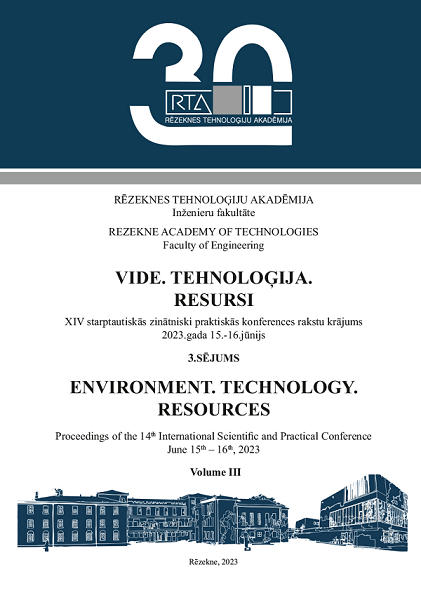INFLUENCE OF BASIC PARAMETERS OF THE LASER MARKING PROCESS ON STAINLESS STEEL SAMPLES
DOI:
https://doi.org/10.17770/etr2023vol3.7216Keywords:
contrast, fiber laser, frequency, laser marking, raster step, speed, stainless steel, working intervalsAbstract
The role of basic quantities influencing the process of laser raster marking of AISI 304 stainless steel products using a fiber laser was investigated. Some dependencies were found when changing the contrast of the marking when changing the parameters in wide intervals. As the raster step increases, a non-linear decrease in contrast occurs as the rate of contrast decrease. Regarding the influence of the speed on the contrast, it was found that as the speed increases, the contrast of the marking decreases non-linearly, and as the step increases, the speed of the contrast decrease also increases. Above 20 kHz, the frequency has relatively little influence on the contrast, as with increasing frequency the contrast slowly increases and the dependence is almost linear. The effective energy is strongly influenced by the contrast. At effective energy values below 18 kJ/cm2 the contrast of the marking is insufficient for visual perception of a good quality marking, but in the interval from 6 kJ/cm2 to 46 kJ/cm2 the contrast increases very quickly. At values of the effective energy above 100 kJ/cm2, the contrast of the marking hardly changes.
The obtained results can be used by the operators of laser systems to evaluate the working ranges and quickly determine the boundary areas of the optimal technological parameters when obtaining a good contrast in the laser marking of stainless steels with a fiber laser.
References
T. W. Ng, S. C., Yeo, Aesthetic laser marking assessment, Optics & Laser Technology, Volume 32, Issue 3, pp. 187-191, April 2000, DOI: https://doi.org/10.1016/S0030-3992(00)00040-2
N. G. Henriksen., Z. O. Andersen, and S. M. Jellesen, Christiansen T. L., Somers A. J., Influence of Laser Marking on Microstructure and Corrosion Performance of Martensitic Stainless Steel Surfaces for Biomedical Applications, Journal of Heat Treatment and Materials, June 21 2022, DOI: https://doi.org/10.1515/htm-2022-1010
F. Bravo-Montero , D. Castells-Rufas, and J. Carrabina, High-Speed Laser Marking with Diode Arrays, Optics and Laser Technology, Volume 146, 107551, February 2022, DOI: https://doi.org/10.1016/j.optlastec.2021.107551
L. Sobotova, M. Badida, Laser marking as environment technology, Open Engineering, 7:303–316, 2017, DOI: https://doi.org/10.1515/eng-2017-0030
Ts. Zlateva-Petkova., Planning and forecasting future demand for employees, International Conference “Economics and management – based on new technologies”, EMoNT 2016, Vrnjacka Banja, Serbia, pp. 401-406, 16-19 June 2016, ISBN: 978-86-6075-059-6
D. Dichev, I. Zhelezarov, and G. Cvetanov, "Algorithm for estimation and correction of dynamic errors," 30th International Scientific Symposium Metrology and Metrology Assurance, MMA September 7 -11 2020, Sozopol, Bulgaria, 2020, DOI: 10.1109/MMA49863.2020.9254261
X. Maa, X. Niea, and J. Guoa, Effect of nanosecond pulsed laser parameters on the color making of 304 stainless steel, Optics & Laser Technology, 106104, 2020, DOI: https://doi.org/10.1016/j.optlastec.2020.106104
S. J. Foster, K. Carver, and S. S. Babu, Process-defect-structure-property correlations during laser powder bed fusion of alloy 718: role of in situ and ex situ characterizations, Metallurgical and Materials Transactions, 49:5775-98., 2018; DOI: https://www.doi.org/10.1007/s11661-018-4870-2
A. H. Maamoun, Y. F. Xue, and S. C. Veldhuis, Effect of Selective Laser Melting Process Parameters on the Quality of Al Alloy Parts: Powder Characterization, Density, Surface Roughness, and Dimensional Accuracy, Materials, 11(12), 2018, DOI: 10.3390/ma11122343
C. Leone, S. Genna, and I. D. Iorio, AISI 304 stainless steel marking by a Q-switched diode pumped Nd:YAG laser, Journal of Materials Processing Technology 210 , pp. 1297–1303, 2010, DOI: https://doi.org/10.1016/j.jmatprotec.2010.03.018
X. Maa, X. Niea, and J. Guoa, Coloring stability analysis of nanosecond pulsed laser induced surface coloring on stainless steel, Optics and Laser Technology, 123, 105936, 2020, DOI: https://doi.org/10.1016/j.optlastec.2019.105936
H. Oh., J. Kim., and M. Lee, Structural coloration of stainless steel with planar thin-film surface cavity structure, Optical Materials, 100, 109547, 2020, DOI: https://doi.org/10.1016/j.optmat.2019.109547
J. Penidea, F. Quinteroa, and J. Poua, High contrast laser marking of alumina Applied Surface Science, 336, pp. 118–128, 2015, DOI: http://dx.doi.org/10.1016/j.apsusc.2014.10.004
Y. Arshad, R. Linggamm, and A. Qaban, Laser Surface Modification of Duplex Stainless Steel 2205 to Modify the Surface Roughness, International Journal of Automotive and Mechanical Engineering (IJAME), Volume18, Issue 2, pp. 8695-8703, 2021, DOI: https://doi.org/10.15282/ijame.18.2.2021.07.0663
R. Cottam, Laser Materials Processing for Improved Corrosion Performance, Environmental and Industrial Corrosion - Practical and Theoretical Aspects, pp. 3-18, 2012, DOI: http://dx.doi.org/10.5772/52423



